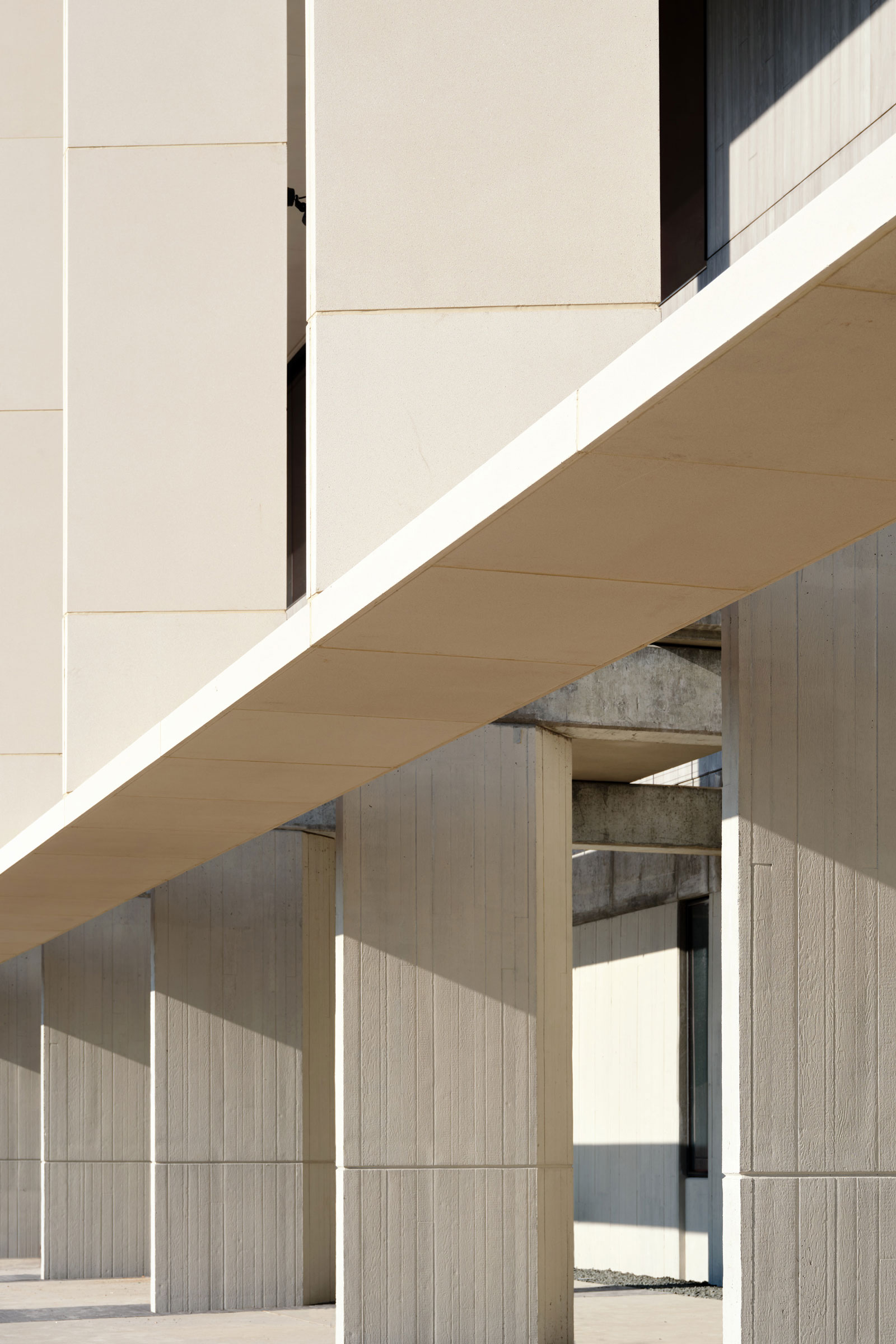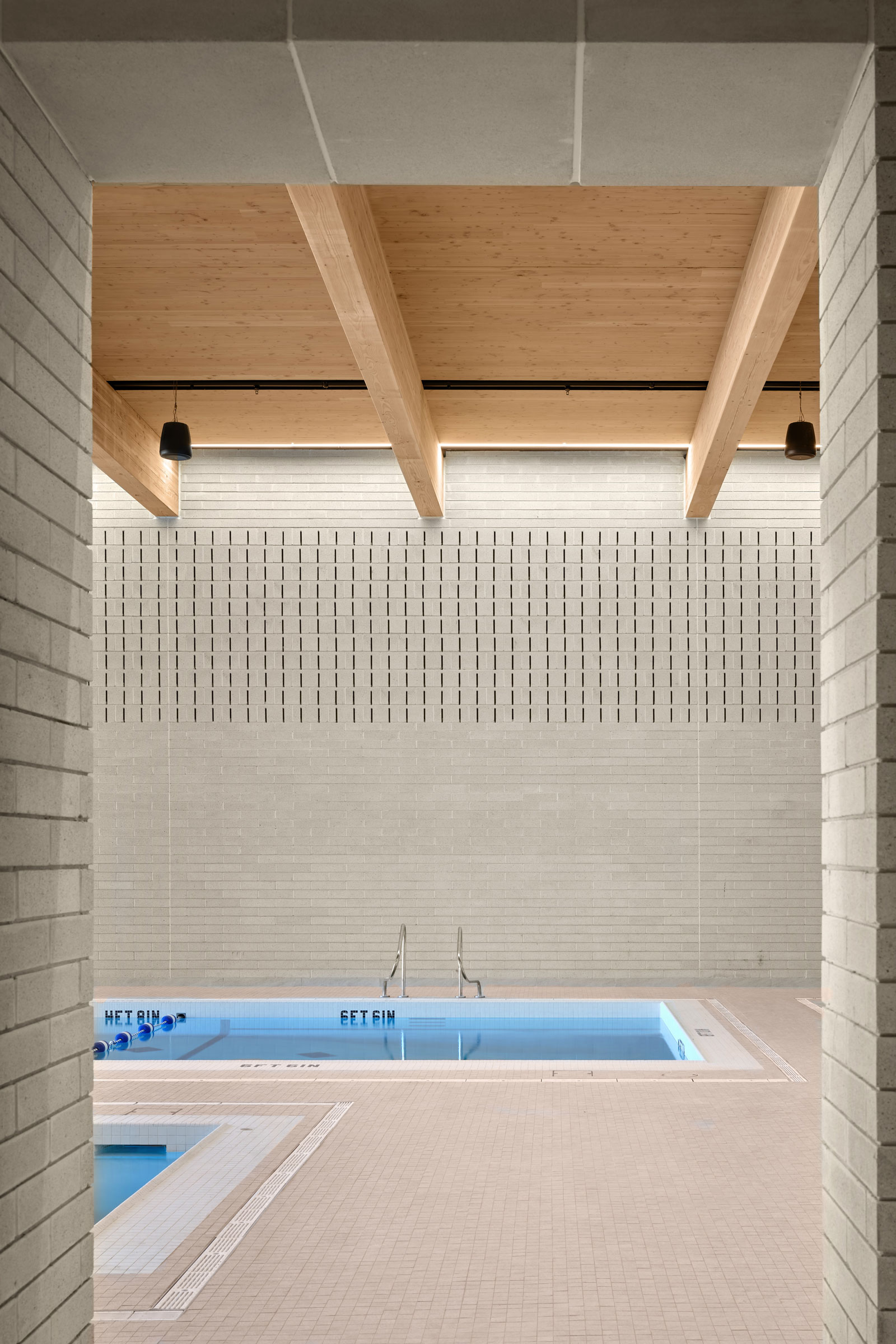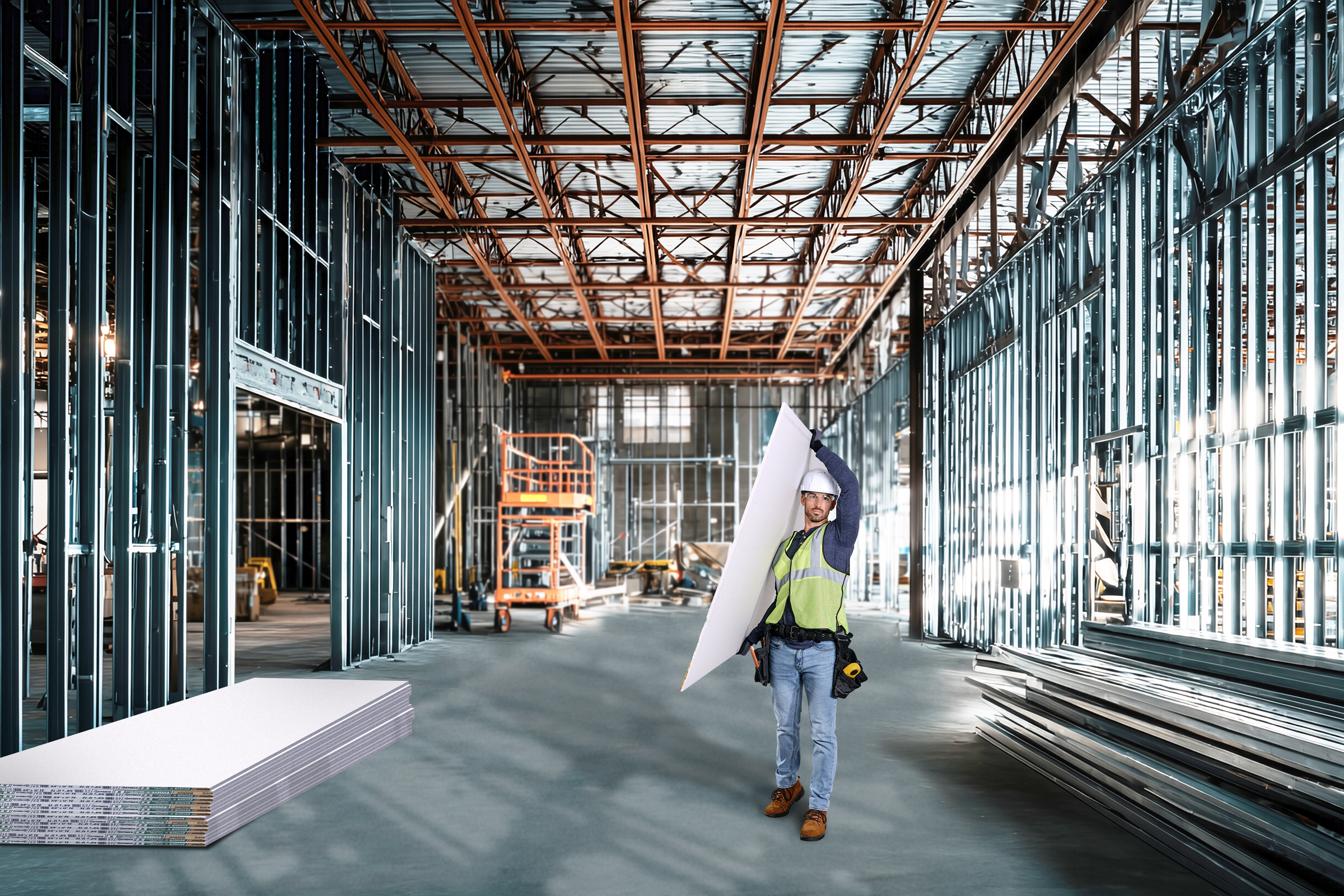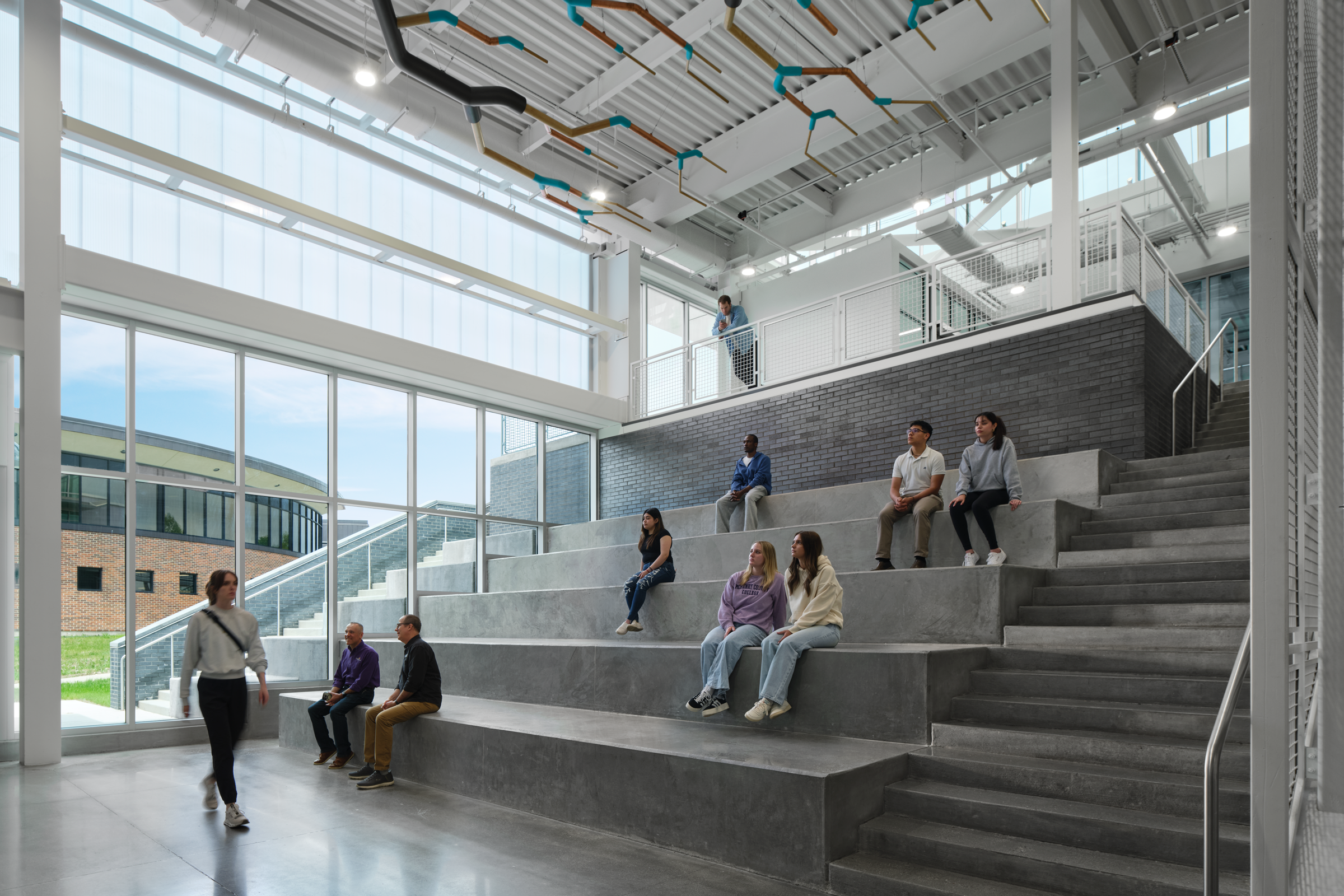Story at a glance:
- Architecture firm ZGF designed the new San Antonio Spurs’ new world-class practice facility—the largest mass timber constructed training center in professional sports.
- Balance—between public and private spaces, mental and physical well-being, the use of shadow and light—is constantly at play in the design of the new San Antonio Spurs’ facility.
Jetting across time zones. Unpredictable schedules. Transitioning from professional basketball arenas to airplanes to parking lots and back to training facilities. The San Antonio Spurs’ athletes spend an unusual amount of time indoors, constantly making demands on their minds and bodies. So when the leaders of the Spurs organization began developing plans for the new Victory Capital Performance Center, considering the players’ holistic well-being was essential.
It took a decade of traveling, touring, and research along with consultations with the architectural leaders at ZGF to land on a future-proof biophilic design that would give the Spurs an edge in professional sports while providing a restorative space for the players to feel grounded and reconnected with nature.
“We knew this building had to be of its place, connected to the community and its fan base but also rooted in the land from which they rise,” says Kathy Berg, ZGF’s lead design architect. “You know you’re in San Antonio when you’re there. The historic missions that glow this intense yellow-orange in the early morning light; they’re beautiful and were a huge inspiration for us.”
Built seamlessly into the limestone landscape at the foot of the Texas Hill Country, the Victory Capital Performance Center is 138,000 square feet of practice courts, locker rooms, training areas, strength and conditioning spaces, recovery spaces with hydrotherapy pools, a sauna, float tanks, kitchen, meeting spaces, an outdoor training area, and more. The training center anchors a multi-building, 45-acre campus focused on the advancement of human performance and boasts a grand three-story facade facing a public plaza that tapers into more intimate, residential interiors with landscaped outdoor oases tucked away from public view.
Sustainability
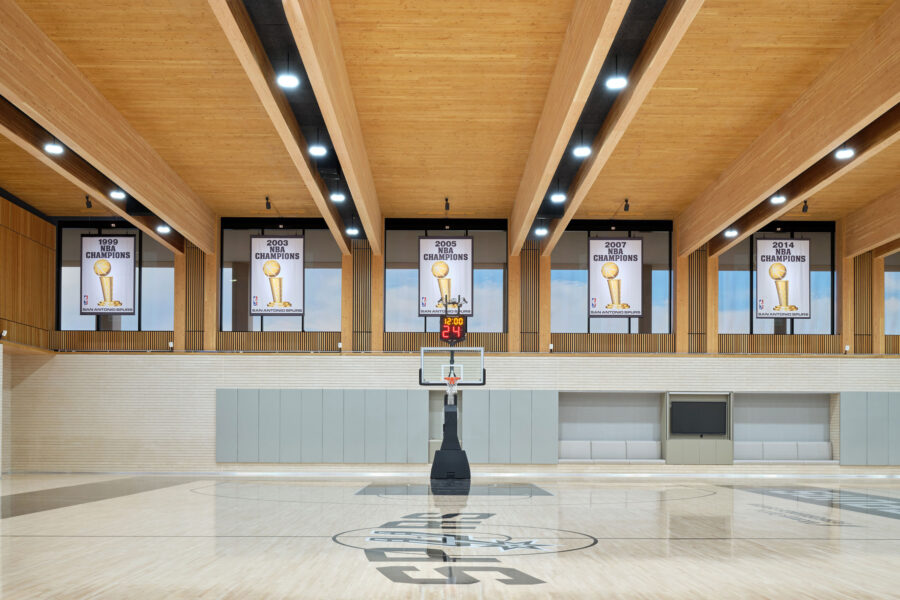
Once wood was determined as the key element in the center’s biophilic design, Texas-based Timberlyne became an essential player in the engineering, fabrication, and erection of the mass timber structure, which included wooden columns and 150-foot long beams—the largest on the market at the time—from American Laminators and Duco-Lam. Photo by Dror Baldinger
Connecting the players to nature even when they are indoors was a driving force in the decision to use mass timber construction, as was the fact that mass timber has proven to significantly reduce a building’s embodied carbon.
“Mass timber offered a huge benefit in terms of carbon sequestration and the biophilic feel. So much of the timber is exposed, and it just feels really good,” Berg says. “We also loved that mass timber harkened back to how early structures were built with stone walls and timber roofs, which was a good expression of the local region.”
Mass timber also allowed ZGF to eliminate a second level of materials, since the exposed beams and columns served as the finish.
To further ensure building materials reflected the area, ZGF explored the city’s famed Riverwalk and historic Pearl district, drawing inspiration from the water and concrete structures that help to sustain cooler temperatures in San Antonio’s extreme climate. “Even if it was 106 degrees, you could walk inside these concrete structures and feel the temperature drop,” Berg says. “We had equally amazing moments ascending up and down the Riverwalk. It could be an immensely hot day, but you’d get down to the river and it immediately felt cooler.” ZGF drew on these elements, bringing them into the design with colonnades, courtyards, and the use of water.
Daylight in all of the interior spaces was another way ZGF worked to reduce electric energy used for lighting the building. “It was the players’ unexpected schedules that drove the idea that every occupied space in this building should be daylit, that every space should allow you to look outside and see the environment you’re in, ground yourself, and know what time of day it is,” Berg says.
The one-level building also provided ample roof area and sky access for a massive PV array. A rainwater capture and storage system serves some of the onsite irrigation, an important feature in San Antonio where water is a precious resource. And best practice mechanical elements installed by Arup make the project even more sustainable.
Duality
- The Victory Capital Performance Center needed a heroic public facade and a variety of interior programs that allowed the team’s staff functionality while also giving the players a more intimate space to recover and reconnect. Photo by Dror Baldinger
- The architects drew inspiration from San Antonio’s famed Riverwalk and the historic Pearl District and the concrete structures and water elements that help keep the area cool. Photo by Dror Baldinger
Considering how the building would be used was just as crucial as how it would be built. The Spurs’ referred to their original practice facility as a “fortress of solitude,” and the organization wanted to carry that ethos forward, creating a new center that balanced a fortress-like public front with a private and restorative interior, ensuring players had a safe space to train and focus on their job.
For 55 years innovation has been at the heart of the Spurs organization. ZGF and Spurs leaders toured many two- and three-story facilities, even spaces with no windows, as part of their research. Many of the places they visited were very bespoke—it was going to be challenging for the buildings to evolve with advances in technology and equipment. “The Spurs were constantly asking: How can we future-proof this facility? How can we provide something that will shift and change as technology changes?” Berg recalls.
The Spurs’ analytics team continually focuses on deep-level analysis of the players’ performance and well-being—referencing studies on circadian rhythms, how being exposed to light affects athletes, how players perform when traveling west to east versus east to west. “We spent a lot of time with the organization thinking about how—as technology continues to change—they could integrate that into the facility and not disrupt its functions,” Berg says. “There was a constant intentionality about how people would move through this facility that drove the overall layout.”
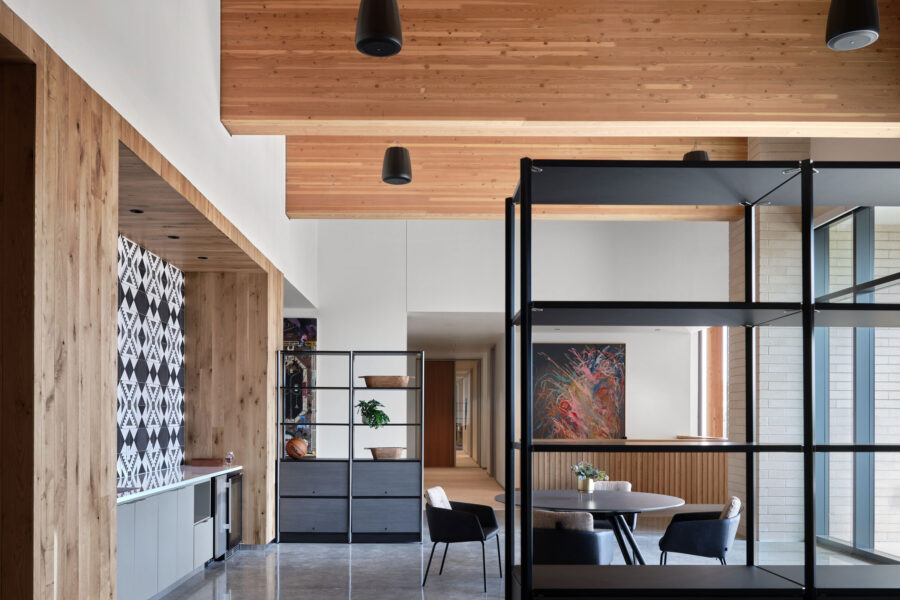
The south elevation evokes the idea of a fortress of solitude. Workspaces are hidden from public view, with daylight channeled inside via a sawtooth facade. Photo by Dror Baldinger
It was essential that the entire organization had spaces to collaborate and hold meetings, that anyone could engage publicly or navigate their way through the building in less public ways, that the players could practice and “pound the rock,” as the Spurs players like to say, but also that everyone inside the building would always have a place to reconnect with nature. Design conversations also consistently revolved around the question of how to give the building a monumental shell while still offering those intimate and biophilic interiors. This impactful public facade was created with board-formed concrete and glass fiber reinforced concrete piers that form a colonnade that utilizes the play of angles and light to convey an image of power and strength or, depending on the time of day, the sense of a light being left on at home.
“On a clear day in that strong San Antonio sunlight, you see the center’s hard exterior shell, the black windows, that give this sense that, ‘Yeah, we’re here. This is a great place to be. But we’re doing work inside,’” Berg says. But then at night as daylight fades, the center shines. “You see the double-lit mass timber beams, the championship banners, and you get that glow of wood in the three-story entry lobby. You get that duality of what happens in the building during the day versus at night.”
Project Details
Project: San Antonio Spurs Victory Capital Performance Center
Location: San Antonio
Completion: 2023
Size: 138,000 square feet
Architect & Interior Design: ZGF Architects
Local Architect: RVK Architecture
Developer: Lincoln Property Company
Structural & MEP Engineer, Lighting Design: Arup
Civil Engineer: Pape-Dawson Engineers
General Contractor: Joeris General Contractors, Sabinal Group
Energy Modeling: Arup
Mass Timber Installer: Timberlyne
Facades: Curtainwall Design Consulting
Landscape Architect: Rialto Studio


